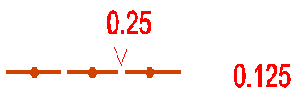
A line joining points of equal height. The standard vertical interval between contours is 5 metres.
Colour: brown.
102 Index contour
Every fifth contour should be drawn with a thicker line. This is an aid to the quick assessment of height difference and the overall shape of the ground. Where one of these contours coincides with an area of small knolls or depressions, it may be shown with a normal contour line.
Colour: brown.
103 Form line
An intermediate contour line. Form lines are used where more information can be given about the shape of the ground. They are used only where representation is not possible with ordinary contours. Only one form line may be used between neighbouring contours.
Colour: brown.

Slope lines may be drawn on the lower side of a contour line, eg along the line of a re-entrant or in a depression. They are used only where it is necessary to clarify the fall of the ground.
Colour: brown.

Contour values are often included to aid assessment of large height differences. They are inserted in the index contours in positions where other detail is not obscured. The figures should be orientated so that the top of the figure is on the higher side of the contour.
Colour: brown.

A steep earth bank is an abrupt change in ground level which can be clearly distinguished from its surroundings, e.g. gravel or sand pits, road and railway cuttings or embankments.The tags should show the full extent of the slope, but may be omitted if two banks are close together. Impassable banks should be drawn with symbol 201 (impassable cliff).
Colour: brown.

Distinct earth wall.
Colour: brown.

A partly ruined earth wall may be shown with a dashed line.
Colour: brown.

An erosion gully or trench which is too small to be shown by symbol 106 is shown by a single line. The line width reflects the size of the gully. Minimum depth 1m. The end of the line is pointed.
Colour: brown.

A small erosion gully or trench. Minimum depth 0.5 m.
Colour: brown.

Knolls are shown with contour lines. A prominent knoll falling between contour lines may still be represented by a contour line if the deviation from the actual contour level is less than 25%. Smaller or flatter knolls should be shown with form lines.
Colour: brown.

A small obvious mound or rocky knoll which cannot be drawn to scale with a contour (diameter of mound less than ca. 5 m). Knolls of any other shape than round should be shown by contours. The height of the knoll should be a minimum of 1m from the surrounding ground.
Colour: brown.

Depressions are shown with contours or form lines and slope lines. Prominent depressions falling between contour lines may be represented by a contour line if the deviation from the actual contour level is less than 25%. Smaller or shallower depressions should be shown by form lines.
Colour: brown.

Small shallow natural depressions and hollows (minimum diameter 2m) which cannot be shown to scale by contours are represented by a semicircle. Minimum depth from the surrounding ground should be 1m. Location is the centre of gravity of the symbol, which is orientated to north. Symbol 115 is used for manmade pits.
Colour: brown.

Pits and holes with distinct steep sides which cannot be shown to scale by symbol 106 (minimum diameter 2m). Pits with any other shape than round should be shown by contours. Minimum depth from the surrounding ground should be 1m. Location is the centre of gravity of the symbol which is orientated to north.
Colour: brown.

An area of pits or knolls which is too intricate to be shown in detail. The density of dots may vary according to the detail on the ground.
Colour: brown.

This symbol can be used for a special small landform feature. The definition of the symbol must be given in the map legend.
Colour: brown.

Spot heights are used for the rough assessment of height differences. The height is given to the nearest metre. The figures are orientated to the north. Water levels are given without the dot.
Colour: black.








